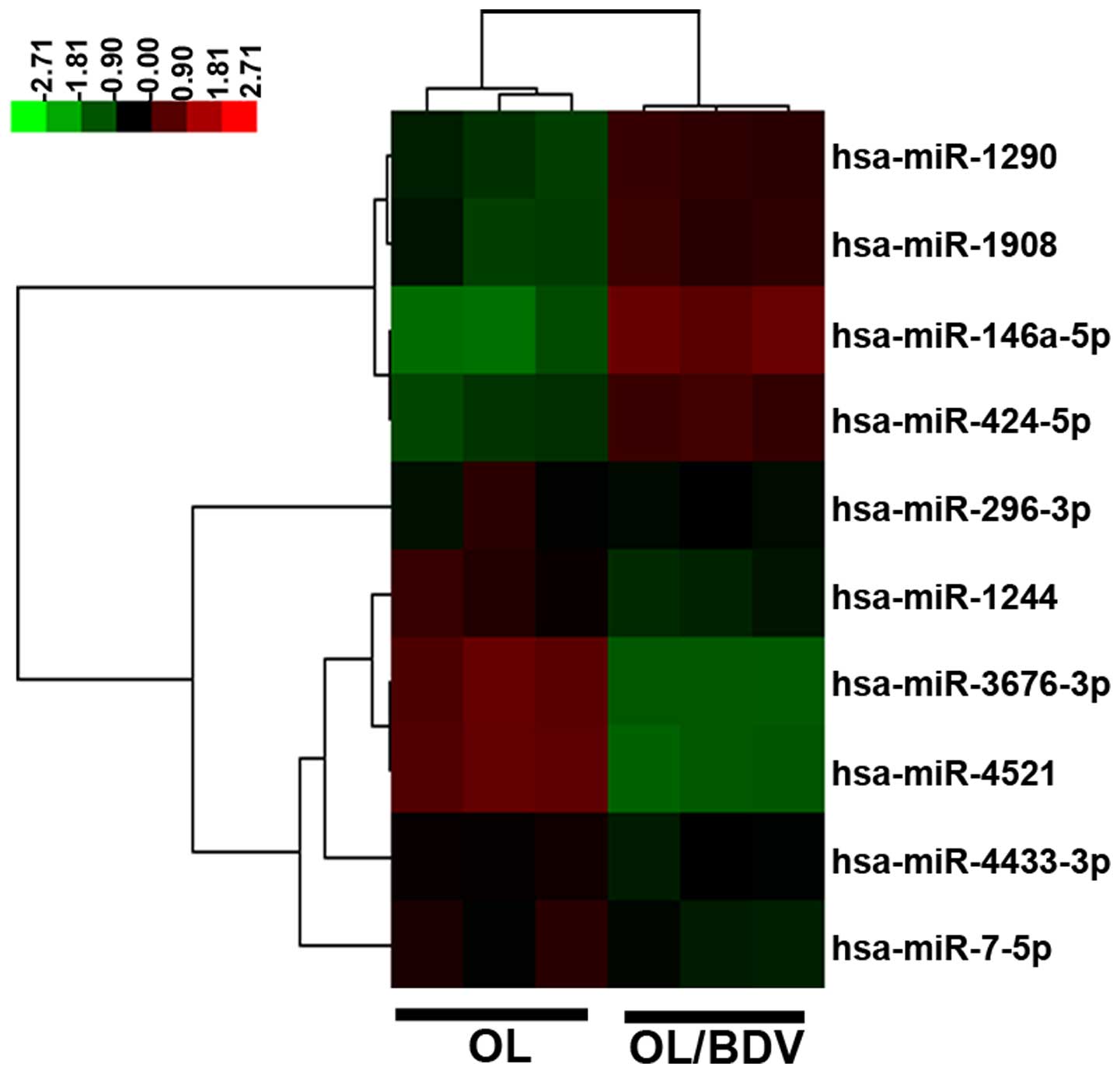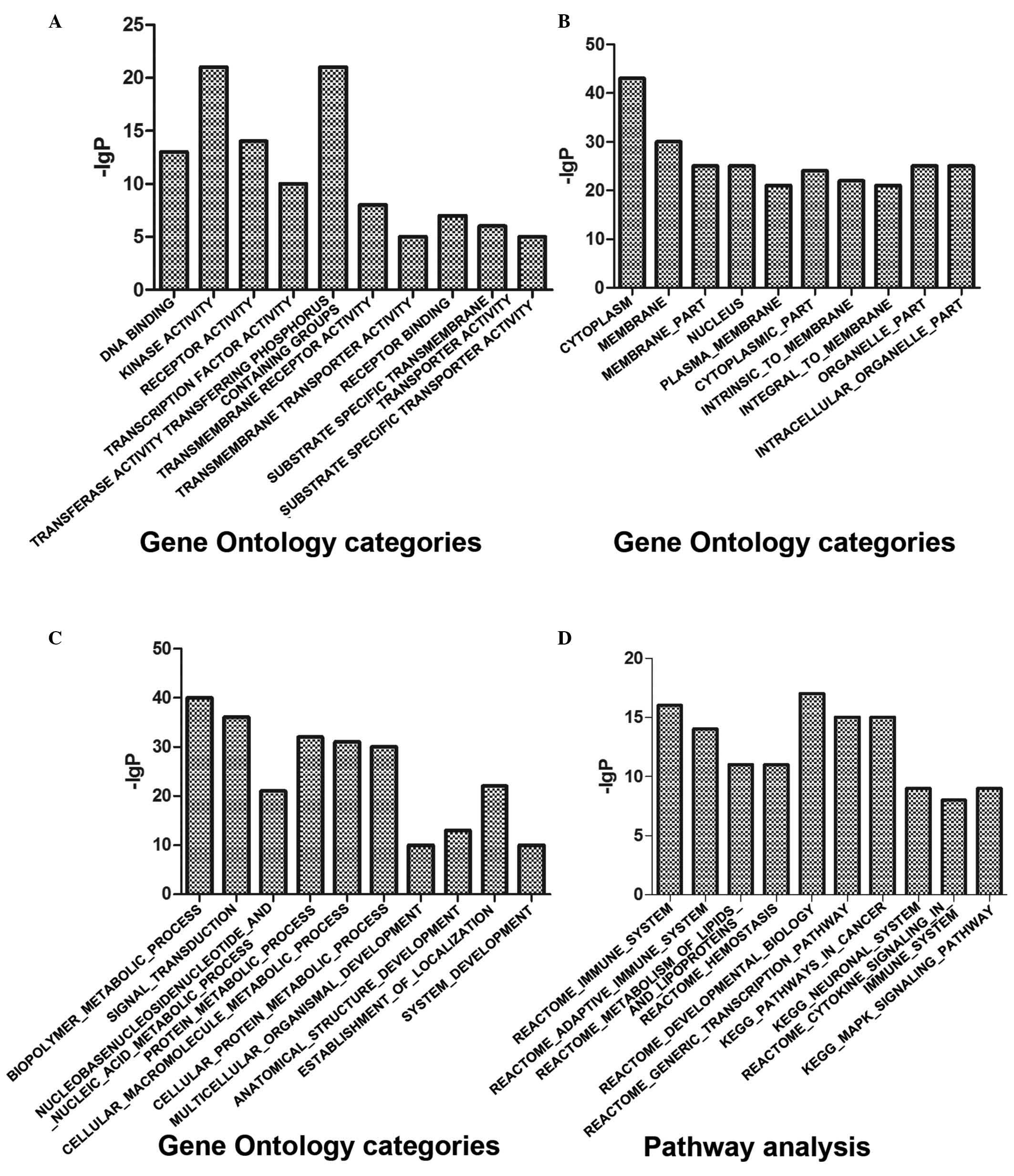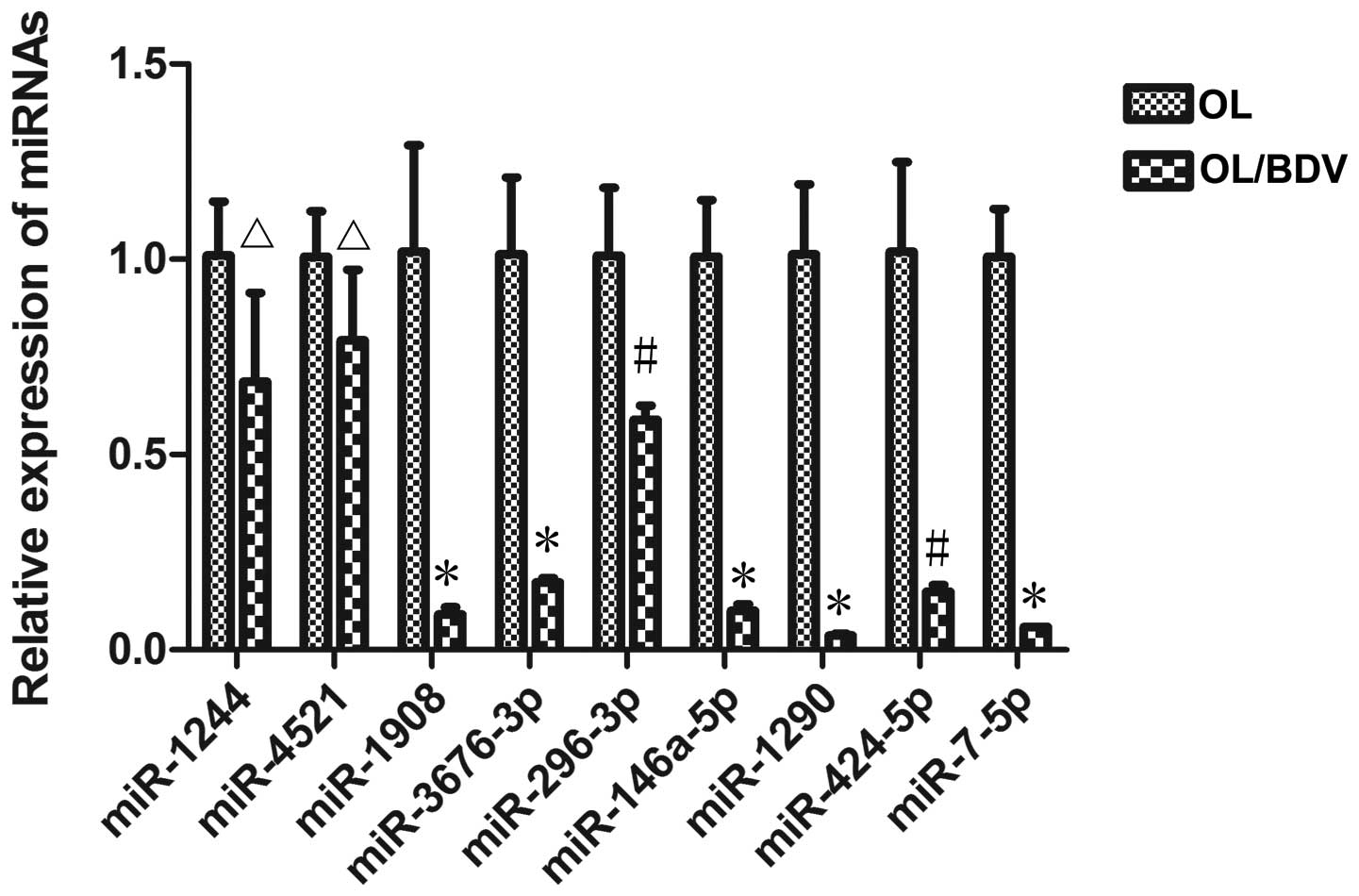|
1
|
Briese T, Schneemann A, Lewis AJ, Park YS,
Kim S, Ludwig H and Lipkin WI: Genomic organization of Borna
disease virus. Proc Natl Acad Sci USA. 91:4362–4366. 1994.
View Article : Google Scholar : PubMed/NCBI
|
|
2
|
Cubitt B, Oldstone C and de la Torre JC:
Sequence and genome organization of Borna disease virus. J Virol.
68:1382–1396. 1994.PubMed/NCBI
|
|
3
|
Ludwig H and Bode L: Borna disease virus:
New aspects on infection, disease, diagnosis and epidemiology. Rev
Sci Tech. 19:259–288. 2000.PubMed/NCBI
|
|
4
|
Ludwig H, Bode L and Gosztonyi G: Borna
disease: A persistent virus infection of the central nervous
system. Prog Med Virol. 35:107–151. 1988.PubMed/NCBI
|
|
5
|
Horie M, Honda T, Suzuki Y, Kobayashi Y,
Daito T, Oshida T, Ikuta K, Jern P, Gojobori T, Coffin JM and
Tomonaga K: Endogenous non-retroviral RNA virus elements in
mammalian genomes. Nature. 463:84–87. 2010. View Article : Google Scholar : PubMed/NCBI
|
|
6
|
Wang X, Zhang L, Lei Y, Liu X, Zhou X, Liu
Y, Wang M, Yang L, Zhang L, Fan S and Xie P: Meta-analysis of
infectious agents and depression. Sci Rep. 4:45302014.PubMed/NCBI
|
|
7
|
Bode L, Reckwald P, Severus WE, Stoyloff
R, Ferszt R, Dietrich DE and Ludwig H: Borna disease virus-specific
circulating immune complexes, antigenemia, and free antibodies-the
key marker triplet determining infection and prevailing in severe
mood disorders. Mol Psychiatry. 6:481–491. 2001. View Article : Google Scholar : PubMed/NCBI
|
|
8
|
Bode L, Zimmermann W, Ferszt R, Steinbach
F and Ludwig H: Borna disease virus genome transcribed and
expressed in psychiatric patients. Nat Med. 1:232–236. 1995.
View Article : Google Scholar : PubMed/NCBI
|
|
9
|
Fu ZF, Amsterdam JD, Kao M, Shankar V,
Koprowski H and Dietzschold B: Detection of Borna disease
virus-reactive antibodies from patients with affective disorders by
western immunoblot technique. J Affect Disord. 27:61–68. 1993.
View Article : Google Scholar : PubMed/NCBI
|
|
10
|
Rott R, Herzog S, Fleischer B, Winokur A,
Amsterdam J, Dyson W and Koprowski H: Detection of serum antibodies
to Borna disease virus in patients with psychiatric disorders.
Science. 228:755–756. 1985. View Article : Google Scholar : PubMed/NCBI
|
|
11
|
Sauder C, Müller A, Cubitt B, Mayer J,
Steinmetz J, Trabert W, Ziegler B, Wanke K, Mueller-Lantzsch N, de
la Torre JC and Grässer FA: Detection of Borna disease virus (BDV)
antibodies and BDV RNA in psychiatric patients: Evidence for high
sequence conservation of human blood-derived BDV RNA. J Virol.
70:7713–7724. 1996.PubMed/NCBI
|
|
12
|
Thakur R, Sarma S and Sharma B: Role of
Borna disease virus in neuropsychiatric illnesses: Are we inching
closer? Indian J Med Microbiol. 27:191–201. 2009. View Article : Google Scholar : PubMed/NCBI
|
|
13
|
Zhang L, Xu MM, Zeng L, Liu S, Liu X, Wang
X, Li D, Huang RZ, Zhao LB, Zhan QL, et al: Evidence for Borna
disease virus infection in neuropsychiatric patients in three
western China provinces. Eur J Clin Microbiol Infect Dis.
33:621–627. 2014. View Article : Google Scholar : PubMed/NCBI
|
|
14
|
Liu X, Bode L, Zhang L, Wang X, Liu S,
Zhang L, Huang R, Wang M, Yang L, Chen S, et al: Health care
professionals at risk of infection with Borna disease
virus-evidence from a large hospital in China (Chongqing). Virol J.
12:392015. View Article : Google Scholar : PubMed/NCBI
|
|
15
|
Hornig M, Briese T, Licinio J, Khabbaz RF,
Altshuler LL, Potkin SG, Schwemmle M, Siemetzki U, Mintz J,
Honkavuori K, et al: Absence of evidence for bornavirus infection
in schizophrenia, bipolar disorder and major depressive disorder.
Mol Psychiatry. 17:486–493. 2012. View Article : Google Scholar : PubMed/NCBI
|
|
16
|
Evengård B, Briese T, Lindh G, Lee S and
Lipkin WI: Absence of evidence of Borna disease virus infection in
Swedish patients with Chronic Fatigue Syndrome. J Neurovirol.
5:495–499. 1999. View Article : Google Scholar : PubMed/NCBI
|
|
17
|
Wolff T, Heins G, Pauli G, Burger R and
Kurth R: Failure to detect Borna disease virus antigen and RNA in
human blood. J Clin Virol. 36:309–311. 2006. View Article : Google Scholar : PubMed/NCBI
|
|
18
|
Scordel C, Huttin A, Cochet-Bernoin M,
Szelechowski M, Poulet A, Richardson J, Benchoua A, Gonzalez-Dunia
D, Eloit M and Coulpier M: Borna disease virus phosphoprotein
impairs the developmental program controlling neurogenesis and
reduces human GABAergic neurogenesis. PLoS Pathog. 11:e10048592015.
View Article : Google Scholar : PubMed/NCBI
|
|
19
|
Hans A, Syan S, Crosio C, Sassone-Corsi P,
Brahic M and Gonzalez-Dunia D: Borna disease virus persistent
infection activates mitogen-activated protein kinase and blocks
neuronal differentiation of PC12 cells. J Biol Chem. 276:7258–7265.
2001. View Article : Google Scholar : PubMed/NCBI
|
|
20
|
Hans A, Bajramovic JJ, Syan S, Perret E,
Dunia I, Brahic M and Gonzalez-Dunia D: Persistent, noncytolytic
infection of neurons by Borna disease virus interferes with ERK 1/2
signaling and abrogates BDNF-induced synaptogenesis. FASEB J.
18:863–865. 2004.PubMed/NCBI
|
|
21
|
Kamitani W, Ono E, Yoshino S, Kobayashi T,
Taharaguchi S, Lee BJ, Yamashita M, Kobayashi T, Okamoto M,
Taniyama H, et al: Glial expression of Borna disease virus
phosphoprotein induces behavioral and neurological abnormalities in
transgenic mice. Proc Natl Acad Sci USA. 100:8969–8974. 2003.
View Article : Google Scholar : PubMed/NCBI
|
|
22
|
Bartel DP: MicroRNAs: Genomics,
biogenesis, mechanism, and function. Cell. 116:281–297. 2004.
View Article : Google Scholar : PubMed/NCBI
|
|
23
|
Ambros V: The functions of animal
microRNAs. Nature. 431:350–355. 2004. View Article : Google Scholar : PubMed/NCBI
|
|
24
|
Mollaie HR, Monavari SH, Arabzadeh SA,
Shamsi-Shahrabadi M, Fazlalipour M and Afshar RM: RNAi and miRNA in
viral infections and cancers. Asian Pac J Cancer Prev.
14:7045–7056. 2013. View Article : Google Scholar : PubMed/NCBI
|
|
25
|
Krol J, Loedige I and Filipowicz W: The
widespread regulation of microRNA biogenesis, function and decay.
Nat Rev Genet. 11:597–610. 2010.PubMed/NCBI
|
|
26
|
Alvarez-Garcia I and Miska EA: MicroRNA
functions in animal development and human disease. Development.
132:4653–4662. 2005. View Article : Google Scholar : PubMed/NCBI
|
|
27
|
Liu X, Zhang L, Cheng K, Wang X, Ren G and
Xie P: Identification of suitable plasma-based reference genes for
miRNAome analysis of major depressive disorder. J Affect Disord.
163:133–139. 2014. View Article : Google Scholar : PubMed/NCBI
|
|
28
|
Fagan AM and Perrin RJ: Upcoming candidate
cerebrospinal fluid biomarkers of Alzheimer's disease. Biomark Med.
6:455–476. 2012. View Article : Google Scholar : PubMed/NCBI
|
|
29
|
Di Y, Lei Y, Yu F, Changfeng F, Song W and
Xuming M: MicroRNAs expression and function in cerebral ischemia
reperfusion injury. J Mol Neurosci. 53:242–250. 2014. View Article : Google Scholar : PubMed/NCBI
|
|
30
|
Lages E, Ipas H, Guttin A, Nesr H, Berger
F and Issartel JP: MicroRNAs: Molecular features and role in
cancer. Front Biosci (Landmark Ed). 17:2508–2540. 2012. View Article : Google Scholar : PubMed/NCBI
|
|
31
|
Bode L, Dürrwald R, Rantam FA, Ferszt R
and Ludwig H: First isolates of infectious human Borna disease
virus from patients with mood disorders. Mol Psychiatry. 1:200–212.
1996.PubMed/NCBI
|
|
32
|
Huang R, Gao H, Zhang L, Jia J, Liu X,
Zheng P, Ma L, Li W, Deng J, Wang X, et al: Borna disease virus
infection perturbs energy metabolites and amino acids in cultured
human oligodendroglia cells. PLoS One. 7:e446652012. View Article : Google Scholar : PubMed/NCBI
|
|
33
|
Liu X, Zhao L, Yang Y, Bode L, Huang H,
Liu C, Huang R, Zhang L, Wang X, Zhang L, et al: Human borna
disease virus infection impacts host proteome and histone lysine
acetylation in human oligodendroglia cells. Virology 464–465.
196–205. 2014. View Article : Google Scholar
|
|
34
|
Zhang L, Wang X, Zhan Q, Wang Z, Xu M, Zhu
D, He F, Liu X, Huang R, Li D, et al: Evidence for natural Borna
disease virus infection in healthy domestic animals in three areas
of western China. Arch Virol. 159:1941–1949. 2014. View Article : Google Scholar : PubMed/NCBI
|
|
35
|
Zhang L, Liu S, Zhang L, You H, Huang R,
Sun L, He P, Chen S, Zhang H and Xie P: Real-time qPCR identifies
suitable reference genes for Borna disease virus-infected rat
cortical neurons. Int J Mol Sci. 15:21825–21839. 2014. View Article : Google Scholar : PubMed/NCBI
|
|
36
|
Zhang L, Wang X, Zhan Q, Wang Z, Xu M, Zhu
D, He F, Liu X, Huang R, Li D, Lei Y and Xie P: Evidence for
natural Borna disease virus infection in healthy domestic animals
in three areas of western China. Arch Virol. 159:1941–1949. 2014.
View Article : Google Scholar : PubMed/NCBI
|
|
37
|
Perkins JR, Dawes JM, McMahon SB, Bennett
DL, Orengo C and Kohl M: ReadqPCR and NormqPCR: R packages for the
reading, quality checking and normalisation of RT-qPCR
quantification cycle (Cq) data. BMC genomics. 13:2962012.
View Article : Google Scholar : PubMed/NCBI
|
|
38
|
Li D, Lei Y, Deng J, Zhou C, Zhang Y, Li
W, Huang H, Cheng S, Zhang H, Zhang L, et al: Human but not
laboratory borna disease virus inhibits proliferation and induces
apoptosis in human oligodendrocytes in vitro. PLoS One.
8:e666232013. View Article : Google Scholar : PubMed/NCBI
|
|
39
|
Liu X, Yang Y, Zhao M, Bode L, Zhang L,
Pan J, Lv L, Zhan Y, Liu S, Zhang L, et al: Proteomics reveal
energy metabolism and mitogen-activated protein kinase signal
transduction perturbation in human Borna disease virus
Hu-H1-infected oligodendroglial cells. Neuroscience. 268:284–296.
2014. View Article : Google Scholar : PubMed/NCBI
|
|
40
|
Lei Y, Li D, Deng J, et al: Metabolomic
profiling of three brain regions from a postnatal infected Borna
disease virus Hu-H1 rat model. Metabolomics. 10:484–495. 2014.
View Article : Google Scholar
|
|
41
|
Strickland ER, Hook MA, Balaraman S, Huie
JR, Grau JW and Miranda RC: MicroRNA dysregulation following spinal
cord contusion: Implications for neural plasticity and repair.
Neuroscience. 186:146–160. 2011. View Article : Google Scholar : PubMed/NCBI
|
|
42
|
Zhao M, Sun L, Chen S, Li D, Zhang L, He
P, Liu X, Zhang L, Zhang H, Yang D, et al: Borna disease virus
infection impacts microRNAs associated with nervous system
development, cell differentiation, proliferation and apoptosis in
the hippocampi of neonatal rats. Mol Med Rep. 12:3697–3703.
2015.PubMed/NCBI
|
|
43
|
Liu Z, Liu Y, Li L, Xu Z, Bi B, Wang Y and
Li JY: MiR-7-5p is frequently downregulated in glioblastoma
microvasculature and inhibits vascular endothelial cell
proliferation by targeting RAF1. Tumour Biol. 35:10177–10184. 2014.
View Article : Google Scholar : PubMed/NCBI
|
|
44
|
Fang Y, Xue JL, Shen Q, Chen J and Tian L:
MicroRNA-7 inhibits tumor growth and metastasis by targeting the
phosphoinositide 3-kinase/Akt pathway in hepatocellular carcinoma.
Hepatology. 55:1852–1862. 2012. View Article : Google Scholar : PubMed/NCBI
|
|
45
|
Giles KM, Brown RA, Epis MR, Kalinowski FC
and Leedman PJ: miRNA-7-5p inhibits melanoma cell migration and
invasion. Biochem Biophys Res Commun. 430:706–710. 2013. View Article : Google Scholar : PubMed/NCBI
|
|
46
|
Shi Y, Luo X, Li P, Tan J, Wang X, Xiang T
and Ren G: miR-7-5p suppresses cell proliferation and induces
apoptosis of breast cancer cells mainly by targeting REGγ. Cancer
Lett. 358:27–36. 2015. View Article : Google Scholar : PubMed/NCBI
|
|
47
|
Saydam O, Senol O, Würdinger T, Mizrak A,
Ozdener GB, Stemmer-Rachamimov AO, Yi M, Stephens RM, Krichevsky
AM, Saydam N, et al: miRNA-7 attenuation in Schwannoma tumors
stimulates growth by upregulating three oncogenic signaling
pathways. Cancer Res. 71:852–861. 2011. View Article : Google Scholar : PubMed/NCBI
|
|
48
|
Wu DG, Wang YY, Fan LG, Luo H, Han B, Sun
LH, Wang XF, Zhang JX, Cao L, Wang XR, et al: MicroRNA-7 regulates
glioblastoma cell invasion via targeting focal adhesion kinase
expression. Chin Med J (Engl). 124:2616–2621. 2011.PubMed/NCBI
|
|
49
|
Kong X, Li G, Yuan Y, He Y, Wu X, Zhang W,
Wu Z, Chen T, Wu W, Lobie PE and Zhu T: MicroRNA-7 inhibits
epithelial-to-mesenchymal transition and metastasis of breast
cancer cells via targeting FAK expression. PLoS One. 7:e415232012.
View Article : Google Scholar : PubMed/NCBI
|
|
50
|
Zhao X, Dou W, He L, Liang S, Tie J, Liu
C, Li T, Lu Y, Mo P, Shi Y, et al: MicroRNA-7 functions as an
anti-metastatic microRNA in gastric cancer by targeting
insulin-like growth factor-1 receptor. Oncogene. 32:1363–1372.
2013. View Article : Google Scholar : PubMed/NCBI
|
|
51
|
Wu K, Hu G, He X, Zhou P, Li J, He B and
Sun W: MicroRNA-424-5p suppresses the expression of SOCS6 in
pancreatic cancer. Pathol Oncol Res. 19:739–748. 2013. View Article : Google Scholar : PubMed/NCBI
|
|
52
|
Zhang Y, Li T, Guo P, Kang J, Wei Q, Jia
X, Zhao W, Huai W, Qiu Y, Sun L and Han L: MiR-424-5p reversed
epithelial-mesenchymal transition of anchorage-independent HCC
cells by directly targeting ICAT and suppressed HCC progression.
Sci Rep. 4:62482014. View Article : Google Scholar : PubMed/NCBI
|
|
53
|
Bai Y, Liao H, Liu T, Zeng X, Xiao F, Luo
L, Guo H and Guo L: MiR-296-3p regulates cell growth and multi-drug
resistance of human glioblastoma by targeting ether-à-go-go (EAG1).
Eur J Cancer. 49:710–724. 2013. View Article : Google Scholar : PubMed/NCBI
|
|
54
|
Kolodziejek J, Dürrwald R, Herzog S,
Ehrensperger F, Lussy H and Nowotny N: Genetic clustering of Borna
disease virus natural animal isolates, laboratory and vaccine
strains strongly reflects their regional geographical origin. J Gen
Virol. 86:385–398. 2005. View Article : Google Scholar : PubMed/NCBI
|
|
55
|
Zhai A, Qian J, Kao W, Li A, Li Y, He J,
Zhang Q, Song W, Fu Y, Wu J, et al: Borna disease virus encoded
phosphoprotein inhibits host innate immunity by regulating miR-155.
Antiviral Res. 98:66–75. 2013. View Article : Google Scholar : PubMed/NCBI
|












